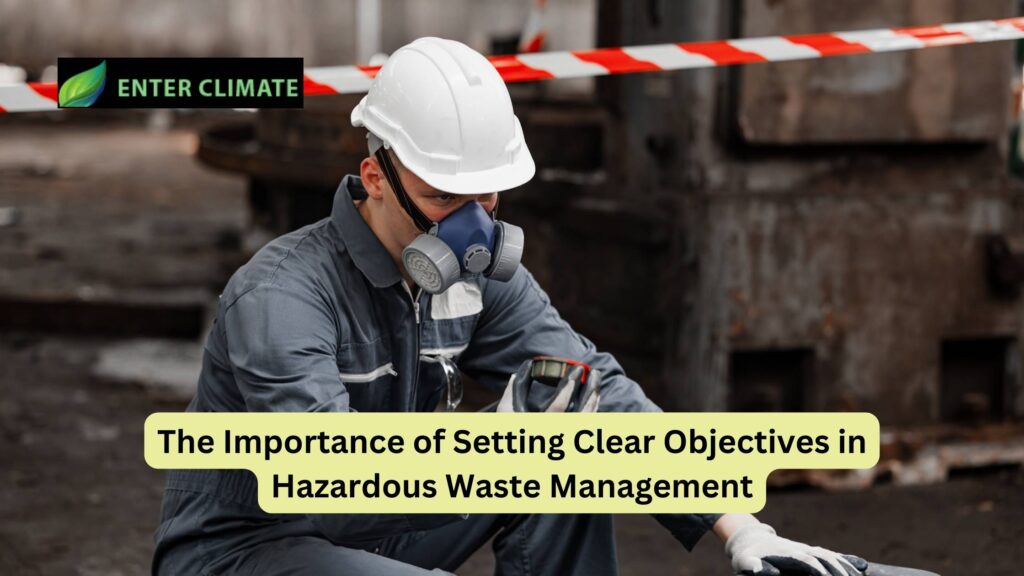Hazardous waste management is a critical aspect of modern business practices, and one that carries significant responsibility. Whether you’re in manufacturing, healthcare, construction, or any industry that generates hazardous materials, your business is tasked with managing waste in a way that complies with regulations, protects workers and the environment, and reduces risk.
However, effective hazardous waste management doesn’t just happen by chance. It requires a structured approach, with well-defined goals and objectives. Setting clear objectives is vital for maintaining safety, ensuring legal compliance, reducing environmental impact, and fostering sustainability. In this blog, we’ll explore why having clear objectives in place is so important for businesses and provide practical insights on how to establish and meet those goals.
1. Ensuring Compliance with Legal Regulations
One of the primary objectives in hazardous waste management is to comply with local, national, and international regulations that govern the handling, disposal, and transportation of hazardous materials. Laws like the Hazardous Waste (Management, Handling, and Transboundary Movement) Rules, 2016 in India or Resource Conservation and Recovery Act (RCRA) in the United States are put in place to safeguard the environment and human health. Non-compliance can lead to severe legal and financial penalties, including fines and reputational damage.
Setting clear objectives for compliance helps ensure that your business remains on track with regulatory requirements. By defining specific goals related to compliance, such as proper waste classification, timely reporting, and safe disposal practices, you reduce the risk of inadvertent violations and demonstrate your commitment to environmental responsibility.
Best Practices for Legal Compliance:
- Regular audits: Conduct periodic internal and external audits to assess your compliance with waste management laws.
- Training programs: Provide continuous training for employees to ensure they understand the latest regulatory requirements.
- Documentation: Keep accurate records of hazardous waste generation, storage, and disposal practices.
Clear objectives around compliance make it easier for businesses to navigate the complex legal landscape and avoid costly mistakes.
2. Protecting Worker and Public Safety
Hazardous waste can pose significant risks to human health. Chemicals, heavy metals, and toxic by-products can cause injuries, illnesses, or even fatalities if not properly handled. Setting safety objectives is therefore an essential part of any hazardous waste management strategy. Businesses must ensure that both their workers and the public are protected from exposure to dangerous materials.
Clear objectives related to worker and public safety help ensure that adequate protective measures are in place. These might include proper training, the use of personal protective equipment (PPE), safe waste storage practices, and emergency response protocols.
Best Practices for Safety:
- PPE and safety training: Ensure employees are properly equipped and trained to handle hazardous waste safely.
- Spill response planning: Have clear procedures in place to respond quickly to accidental spills, leaks, or exposure.
- Regular safety drills: Conduct routine emergency preparedness drills so that employees know how to act in case of a hazardous waste incident.
By setting clear objectives related to safety, businesses can minimize the risks associated with hazardous waste and ensure the well-being of their workforce and the surrounding community.
3. Minimizing Environmental Impact
The environmental consequences of improperly managed hazardous waste are significant. When hazardous materials are improperly stored, transported, or disposed of, they can leak into the environment, contaminating water sources, soil, and air. This can lead to long-term ecological damage and contribute to pollution.
Establishing clear objectives for minimizing environmental impact is essential to sustainable waste management. By focusing on reducing waste generation, implementing recycling programs, and ensuring proper disposal, businesses can contribute to preserving the environment.
Best Practices for Minimizing Environmental Impact:
- Waste reduction: Aim to minimize the generation of hazardous waste through better manufacturing processes or by substituting hazardous materials with safer alternatives.
- Recycling: Where possible, recycle hazardous materials instead of sending them to landfills or incinerators.
- Proper disposal: Ensure that hazardous waste is disposed of through certified, environmentally-friendly methods such as secure landfills or authorized incineration facilities.
By setting clear environmental objectives, businesses contribute to sustainable practices while protecting natural resources.
4. Promoting Sustainability and Waste Minimization
Sustainability is an increasingly important objective for businesses of all sizes. Many organizations are setting goals not just for compliance but to promote long-term environmental stewardship. In the context of hazardous waste management, sustainability is about reducing waste generation, recycling materials, and using resources more efficiently.
Setting clear sustainability objectives encourages businesses to look at the full life cycle of waste, from production to disposal, and find ways to minimize the overall environmental impact. This can help improve efficiency, reduce waste disposal costs, and enhance your company’s reputation as an environmentally responsible business.
Best Practices for Promoting Sustainability:
- Sustainable sourcing: Use materials that are less hazardous or easier to recycle.
- Process optimization: Review and modify production processes to reduce waste generation.
- Eco-friendly packaging: If applicable, choose sustainable packaging that produces less waste and is easier to dispose of.
Having clear sustainability objectives aligned with waste management practices helps businesses operate in an eco-friendly manner, which is increasingly important to consumers, stakeholders, and regulators.
5. Improving Operational Efficiency and Cost Reduction
Setting clear hazardous waste management objectives can also have a direct positive impact on a business’s bottom line. Proper waste management can reduce disposal costs, minimize the need for expensive emergency responses, and improve operational efficiency. For example, reducing hazardous waste production means fewer disposal fees, fewer regulatory fines, and potentially lower insurance premiums.
By incorporating waste minimization strategies, such as optimizing processes or reusing materials, businesses can see cost savings over time. Efficient hazardous waste management can also help reduce the amount of time spent dealing with waste-related issues, allowing businesses to focus on their core operations.
Best Practices for Operational Efficiency:
- Waste audits: Regularly assess your business’s waste generation and disposal practices to identify opportunities for improvement.
- Employee involvement: Engage employees in waste reduction initiatives and incentivize ideas for improving waste management.
- Innovative technologies: Use waste management technologies that increase efficiency, reduce waste, and enhance safety.
Clear objectives for efficiency and cost reduction help businesses realize financial benefits while maintaining effective hazardous waste management practices.
Conclusion: Setting Clear Objectives for a Safer, Sustainable Future
In the evolving landscape of hazardous waste management, businesses need a strategic approach to ensure compliance, protect workers, and reduce environmental impact. Setting clear, measurable objectives for waste management is the foundation of any successful strategy. By defining goals for legal compliance, safety, environmental protection, and sustainability, businesses can create a safer workplace, protect the environment, and improve their operational efficiency.
As hazardous waste management becomes more complex and regulated, having a clear plan in place will be essential for success in the years to come. Whether you’re just starting out or looking to improve existing practices, setting clear objectives will ensure your business not only meets regulatory requirements but also contributes positively to a more sustainable future.
Also, read: How to Audit Your Company’s E-Waste Compliance






